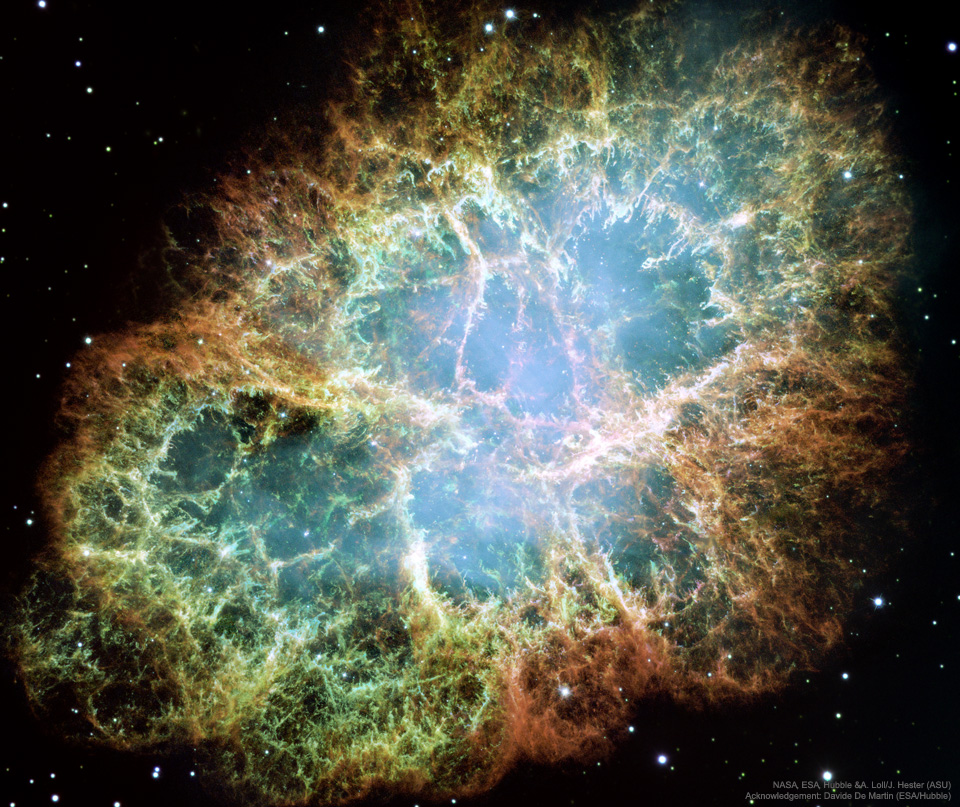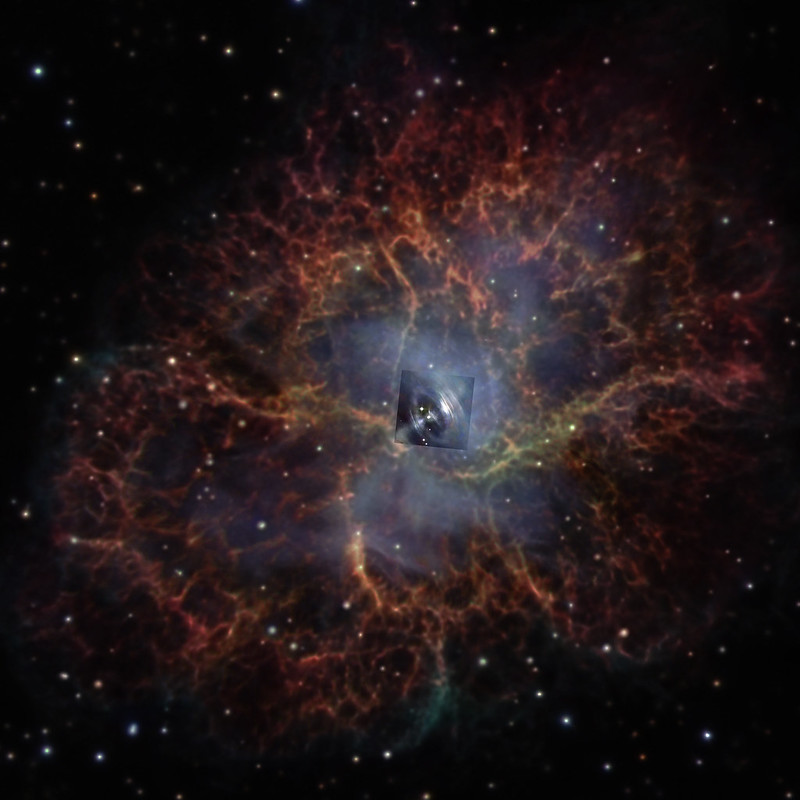Comments and questions about the
APOD on the main view screen.
-
Sa Ji Tario
Post
by Sa Ji Tario » Sun Jan 15, 2023 3:03 pm
In some texts it is mentioned that the expansion is carried out with winds of up to 2,000 km/s and in the 50s of the last century the RF signal became AF, which is heard as the cry of a baby (with the archaic superheterodynes).
-
richardschumacher
Post
by richardschumacher » Sun Jan 15, 2023 4:12 pm
Can you add an arrow to indicate the central star? It's difficult to pick out in this highly detailed image.
-
paul-monat
Post
by paul-monat » Sun Jan 15, 2023 5:15 pm
Question: this explosion happened about 1,000 human-years ago. And now it's 10 LY-wide. Is that speed of light possible? My brain can't figure it out...
-
De58te
- Commander
- Posts: 584
- Joined: Mon Sep 30, 2013 6:35 pm
Post
by De58te » Sun Jan 15, 2023 5:38 pm
paul-monat wrote: ↑Sun Jan 15, 2023 5:15 pm
Question: this explosion happened about 1,000 human-years ago. And now it's 10 LY-wide. Is that speed of light possible? My brain can't figure it out...
First thing to note is that a light year is not a measure of time, but a measure of distance. Now if the Crab Nebula spans 10 ly, then it's radius is 5 light years from the central star. Now if it took 968 years to expand 5 light years, it took 194 years to expand 1 light year. For comparison, with today's rocket speeds it would take a space rocket from Earth close to 18,000 years to travel 1 light year.
-
alter-ego
- Serendipitous Sleuthhound
- Posts: 1121
- Joined: Mon Apr 21, 2008 4:51 am
- Location: Redmond, WA
Post
by alter-ego » Sun Jan 15, 2023 5:45 pm
richardschumacher wrote: ↑Sun Jan 15, 2023 4:12 pm
Can you add an arrow to indicate the central star? It's difficult to pick out in this highly detailed image.
Pulsar identified.
A pessimist is nothing more than an experienced optimist
-
Ann
- 4725 Å
- Posts: 13629
- Joined: Sat May 29, 2010 5:33 am
Post
by Ann » Sun Jan 15, 2023 5:57 pm
richardschumacher wrote: ↑Sun Jan 15, 2023 4:12 pm
Can you add an arrow to indicate the central star? It's difficult to pick out in this highly detailed image.
Ann
Color Commentator
-
alter-ego
- Serendipitous Sleuthhound
- Posts: 1121
- Joined: Mon Apr 21, 2008 4:51 am
- Location: Redmond, WA
Post
by alter-ego » Sun Jan 15, 2023 10:29 pm
Yes. The star Ann appears to be pointing (Arrowed below) to is ~12 arcseconds south of the pulsar. The source below is Aladin. The crab pulsar labeled, and the boxes are stars from Gaia data. Some Gaia data for the pulsar (green highlighted box) is shown at the bottom of the image.
A pessimist is nothing more than an experienced optimist
-
johnnydeep
- Commodore
- Posts: 3045
- Joined: Sun Feb 20, 2011 8:57 pm
Post
by johnnydeep » Sun Jan 15, 2023 10:36 pm
alter-ego wrote: ↑Sun Jan 15, 2023 10:29 pm
Yes. The star Ann appears to be pointing (Arrowed below) to is ~12 arcseconds south of the pulsar. The source below is Aladin. The crab pulsar labeled, and the boxes are stars from Gaia data. Some Gaia data for the pulsar (green highlighted box) is shown at the bottom of the image.
Pulsar ID Correct.JPG
Hmm, do the coordinates shown in the Gaia image match those here? -
https://www.universeguide.com/star/122592/crabpulsar
The location of the pulsar in the night sky is determined by the Right Ascension (R.A.) and Declination (Dec.), these are equivalent to the Longitude and Latitude on Earth. The Right Ascension (Longitude) is expressed in time (hh:mm:ss) and is how far along the celestial equator the star is. If the R.A. is positive, then its eastwards and vice versa.
The Declination (Latitude) is how far north or south the object is compared to the celestial equator and is expressed in degrees. If the value is positive then it is north of the celestial equator. For Crab Pulsar, the location is 05h 34m 31.97s and +22° 00` 52.1 .
Versus the coordinates from Gaia:
The declination seems to match, but does the right ascension?
--
"To B̬̻̋̚o̞̮̚̚l̘̲̀᷾d̫͓᷅ͩḷ̯᷁ͮȳ͙᷊͠ Go......Beyond The F͇̤i̙̖e̤̟l̡͓d͈̹s̙͚ We Know."{ʲₒʰₙNYᵈₑᵉₚ}
-
alter-ego
- Serendipitous Sleuthhound
- Posts: 1121
- Joined: Mon Apr 21, 2008 4:51 am
- Location: Redmond, WA
Post
by alter-ego » Sun Jan 15, 2023 11:04 pm
johnnydeep wrote: ↑Sun Jan 15, 2023 10:36 pm
alter-ego wrote: ↑Sun Jan 15, 2023 10:29 pm
Yes. The star Ann appears to be pointing (Arrowed below) to is ~12 arcseconds south of the pulsar. The source below is Aladin. The crab pulsar labeled, and the boxes are stars from Gaia data. Some Gaia data for the pulsar (green highlighted box) is shown at the bottom of the image.
Pulsar ID Correct.JPG
Hmm, do the coordinates shown in the Gaia image match those here? -
https://www.universeguide.com/star/122592/crabpulsar
The location of the pulsar in the night sky is determined by the Right Ascension (R.A.) and Declination (Dec.), these are equivalent to the Longitude and Latitude on Earth. The Right Ascension (Longitude) is expressed in time (hh:mm:ss) and is how far along the celestial equator the star is. If the R.A. is positive, then its eastwards and vice versa.
The Declination (Latitude) is how far north or south the object is compared to the celestial equator and is expressed in degrees. If the value is positive then it is north of the celestial equator. For Crab Pulsar, the location is 05h 34m 31.97s and +22° 00` 52.1 .
Versus the coordinates from Gaia:
crab pulsar cooirdinates from gaia.png
The declination seems to match, but does the right ascension?
yes, within 7.5E-5 degrees (0.27 arcseconds). Close enough for government work

A pessimist is nothing more than an experienced optimist
-
alter-ego
- Serendipitous Sleuthhound
- Posts: 1121
- Joined: Mon Apr 21, 2008 4:51 am
- Location: Redmond, WA
Post
by alter-ego » Sun Jan 15, 2023 11:52 pm
De58te wrote: ↑Sun Jan 15, 2023 5:38 pm
paul-monat wrote: ↑Sun Jan 15, 2023 5:15 pm
Question: this explosion happened about 1,000 human-years ago. And now it's 10 LY-wide. Is that speed of light possible? My brain can't figure it out...
First thing to note is that a light year is not a measure of time, but a measure of distance. Now if the Crab Nebula spans 10 ly, then it's radius is 5 light years from the central star. Now if it took 968 years to expand 5 light years, it took 194 years to expand 1 light year. For comparison, with today's rocket speeds it would take a space rocket from Earth close to 18,000 years to travel 1 light year.
Crab Nebula expansion over ~16 years (2005 → 2021) is clearly visible in the hover image. The Hubble image date is 2005, and (new) hover image is
2021. The pulsar is identified in both images.
A
decade-long timelapse is visible
hereA pessimist is nothing more than an experienced optimist
-
Guest
Post
by Guest » Mon Jan 16, 2023 2:10 am
De58te wrote: ↑Sun Jan 15, 2023 5:38 pm
paul-monat wrote: ↑Sun Jan 15, 2023 5:15 pm
Question: this explosion happened about 1,000 human-years ago. And now it's 10 LY-wide. Is that speed of light possible? My brain can't figure it out...
First thing to note is that a light year is not a measure of time, but a measure of distance. Now if the Crab Nebula spans 10 ly, then it's radius is 5 light years from the central star. Now if it took 968 years to expand 5 light years, it took 194 years to expand 1 light year. For comparison, with today's rocket speeds it would take a space rocket from Earth close to 18,000 years to travel 1 light year.
Thank you.
-
DL MARTIN
Post
by DL MARTIN » Mon Jan 16, 2023 2:37 am
If the Crab Nebula is 6500 light years away, then does the Chinese sighting of 1054 not represent the instant of the explosion? Rather simply when the observation took place.
-
Avalon
Post
by Avalon » Mon Jan 16, 2023 3:25 am
Is there any way to anticipate a star going super nova, detectable evidence that will predict such an event? I'd love to see a "visiting star" in my lifetime and am just wondering if there is a way to tell if current earth-dwellers have a chance of seeing one. I am fascinated by all of the accounts of the 1054 super nova as recorded by the Chinese and also in beautiful pictorial form by the Anasazi peoples.
-
johnnydeep
- Commodore
- Posts: 3045
- Joined: Sun Feb 20, 2011 8:57 pm
Post
by johnnydeep » Mon Jan 16, 2023 2:07 pm
alter-ego wrote: ↑Sun Jan 15, 2023 11:04 pm
johnnydeep wrote: ↑Sun Jan 15, 2023 10:36 pm
alter-ego wrote: ↑Sun Jan 15, 2023 10:29 pm
Yes. The star Ann appears to be pointing (Arrowed below) to is ~12 arcseconds south of the pulsar. The source below is Aladin. The crab pulsar labeled, and the boxes are stars from Gaia data. Some Gaia data for the pulsar (green highlighted box) is shown at the bottom of the image.
Pulsar ID Correct.JPG
Hmm, do the coordinates shown in the Gaia image match those here? -
https://www.universeguide.com/star/122592/crabpulsar
The location of the pulsar in the night sky is determined by the Right Ascension (R.A.) and Declination (Dec.), these are equivalent to the Longitude and Latitude on Earth. The Right Ascension (Longitude) is expressed in time (hh:mm:ss) and is how far along the celestial equator the star is. If the R.A. is positive, then its eastwards and vice versa.
The Declination (Latitude) is how far north or south the object is compared to the celestial equator and is expressed in degrees. If the value is positive then it is north of the celestial equator. For Crab Pulsar, the location is 05h 34m 31.97s and +22° 00` 52.1 .
Versus the coordinates from Gaia:
crab pulsar cooirdinates from gaia.png
The declination seems to match, but does the right ascension?
yes, within 7.5E-5 degrees (0.27 arcseconds). Close enough for government work

Ah. I was confused by the different units: degrees of RA versus hh:mm:ss of RA, where there are 24 hours in 360 degrees (1 hour is 15 degrees), 60 minutes in 1 hour, and 60 seconds in 1 minute. This calculator will do the conversion -
https://www.vercalendario.info/en/how/c ... hours.html
So, 83.63305 degrees is 5.57553666 hours, 0.5755366 hours is 34.5322 minutes, and 0.5322 minutes is 31.932 seconds , and so, 83.63305° is the same as 5h 34m 31.9s."
--
"To B̬̻̋̚o̞̮̚̚l̘̲̀᷾d̫͓᷅ͩḷ̯᷁ͮȳ͙᷊͠ Go......Beyond The F͇̤i̙̖e̤̟l̡͓d͈̹s̙͚ We Know."{ʲₒʰₙNYᵈₑᵉₚ}
-
AVAO
- Commander
- Posts: 625
- Joined: Tue May 28, 2019 12:24 pm
- AKA: multiwavelength traveller
- Location: Zurich, Switzerland
Post
by AVAO » Tue Jan 17, 2023 1:19 am
alter-ego wrote: ↑Sun Jan 15, 2023 10:29 pm
Yes. The star Ann appears to be pointing (Arrowed below) to is ~12 arcseconds south of the pulsar. The source below is Aladin. The crab pulsar labeled, and the boxes are stars from Gaia data. Some Gaia data for the pulsar (green highlighted box) is shown at the bottom of the image.

I agree with you
 biggg: https://live.staticflickr.com/65535/526 ... 1b8_o.jpg
biggg: https://live.staticflickr.com/65535/526 ... 1b8_o.jpg
jac berne (flickr)
 M1: The Crab Nebula from Hubble
M1: The Crab Nebula from Hubble


